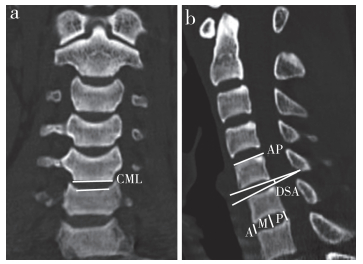颈椎前路椎间盘切除融合术(ACDF)已成为颈椎病前路手术的金标准[1-2],但长期随访发现,ACDF术后相邻节段退行性变(ASD)发生率较高[3-4]。近年来有学者采用椎间盘置换术(TDR)治疗颈椎病,TDR理论上可通过保留手术节段活动度、减轻相邻节段代偿增加的负荷和活动度,降低ASD的发生率[5-6]。随着TDR应用的增多,因颈椎解剖尺寸与人工椎间盘尺寸不匹配导致的并发症也相应增多,其中最常见的是人工椎间盘沉降,因人工椎间盘尺寸过小、应力集中而导致[7]。此外,颈椎解剖尺寸与人工椎间盘尺寸不匹配也可导致异位骨化和异常的颈椎曲度[8]。目前国内临床上常用的人工椎间盘都是根据国外人群(特别是西方人)颈椎尺寸设计的,有研究报道,亚洲人颈椎尺寸小于西方人[9],因此有必要分析国人颈椎解剖数据与常用人工椎间盘尺寸的匹配度,并提出合理的人工椎间盘设计方案。
1 资料与方法 1.1 一般资料收集138例中国患者的颈椎三维CT资料。患者年龄为18 ~ 45岁。纳入标准与Thaler等[10]的研究一致:①非神经根性颈部疼痛;②颈椎三维CT(256排Brilliance iCT,荷兰Philips公司)检查无颈椎退行性变征象(椎间盘突出、骨质增生、后纵韧带骨化等);③C1~7椎体及椎间盘均能在CT图像上显示。排除标准:①神经根型或脊髓型颈椎病;②因骨折、结核或肿瘤导致的骨质破坏;③有颈椎手术史。
1.2 影像学测量138例患者C2/C3、C3/C4、C4/C5、C5/C6、C6/C7共690个节段,采用影像归档和通信系统(PACS,加拿大Carestream Health公司)测量。三维CT测量数据(图 1):①正中冠状面测量各节段上下终板横径;②正中矢状面测量各节段上下终板前后径,各节段椎间盘高度(前高、中高、后高),各节段椎间角度。

|
a:颈椎横径(CML) b:颈椎前后径(AP)、椎间角度(DSA)和椎间隙高度(A:前高;M:中高;P:后高) a:Center mediolateral diameter(CML) b:Anterior-posterior diameter(AP), disc sagittal angle(DSA) and disc height(A:Anterior; M:Middle; P:Posterior) 图 1 CT影像上测量颈椎椎体尺寸 Fig. 1 Measurement of cervical vertebral body size on CT |
所有数据均测量3次,取平均值。将测量数据与常用人工椎间盘尺寸进行比较,分析常用人工椎间盘的尺寸范围是否能够满足各个椎间隙的尺寸范围,如果椎间隙的尺寸没有相应人工椎间盘匹配被认定为不匹配,计算不匹配率。常用人工椎间盘包括Bryan(Medtronic公司,美国)、Prestige LP(Medtronic公司,美国)、Discover(DePuy公司,美国)、Prodisc-C(Synthes公司,美国)。
1.4 统计学处理采用Microsoft Excel 2013统计分析数据,计量资料以x±s表示,计数资料以例数和百分数表示。
2 结果 2.1 颈椎椎体终板前后径匹配度常用人工椎间盘前后径尺寸范围为12 ~ 18 mm,CT测量的国人颈椎终板前后径范围为10.11 ~ 22.88 mm(表 1)。其中,22.54%(311/1 380)的颈椎终板前后径没有合适尺寸的人工椎间盘与其匹配,19.71%(272/1 380)的终板前后径大于最大人工椎间盘前后径。匹配度最差的是C6/C7节段终板前后径与Discover人工椎间盘,不匹配率为57.61%(159/276,表 2);匹配度最好的是C3/C4节段终板前后径与Prodisc-C和Prestige LP人工椎间盘,不匹配率为15.22%(42/276,表 2)。根据4种人工椎间盘尺寸和138例患者CT测量的全部前后径数据比较,匹配度较高的人工椎间盘为Prodisc-C和Prestige LP。
|
|
表 1 颈椎椎体上终板和下终板解剖尺寸 Tab. 1 Anatomical dimensions of upper and lower endplates of cervical spine |
|
|
表 2 颈椎椎体尺寸与常用人工椎间盘的不匹配率 Tab. 2 Mismatch rate between cervical vertebral body size and common artificial intervertebral discs |
常用人工椎间盘横径尺寸范围为14 ~ 19 mm,CT测量的国人颈椎终板横径范围为12.01 ~ 28.18 mm(表 1)。其中,52.61%(726/1 380)的颈椎终板横径与人工椎间盘尺寸不匹配,52.17%(720/1 380)的终板横径大于最大人工椎间盘横径。匹配度最差的为C6/C7节段终板横径与Bryan人工椎间盘,不匹配率为94.93%(262/276,表 2);匹配度最高的是C3/C4节段终板横径与Prodisc-C和Prestige LP人工椎间盘,不匹配率为24.28%(67/276,表 2)。同一节段中,下终板横径与人工椎间盘的不匹配率大于上终板横径,匹配度最差的是C6下终板横径与Bryan人工椎间盘,不匹配度为99.28%(137/138)。根据4种人工椎间盘尺寸和138例患者CT测量的全部横径数据比较,匹配度较高的人工椎间盘为Prodisc-C和Prestige LP。
2.3 椎间隙高度Bryan椎间盘高度不固定,其余人工椎间盘的高度范围为5 ~ 8 mm。人体颈椎椎间隙高度最高为7.75(表 3),因此,人工椎间盘的高度均能适应最大的椎间隙高度。然而,39.12%(270/690)的椎间隙中高低于人工椎间盘的最小高度尺寸。椎间隙的前高和后高均小于椎间隙中高,85.07%(587/690)的椎间隙前高和98.55%(680/690)的椎间隙后高小于人工椎间盘的最小高度尺寸(表 2)。根据4种人工椎间盘尺寸和138例患者CT测量的全部椎间隙高度数据比较,Bryan人工椎间盘因高度可在体内自动调节,更加适合国人普遍较小的椎间隙高度。
|
|
表 3 颈椎椎间隙高度和椎间角度 Tab. 3 Height and angle of cervical intervertebral |
C2/C3、C3/C4、C4/C5、C5/C6、C6/C7节段椎间矢状角分别为3.64°、4.51°、5.04°、5.15°、4.13°,纳入的4种人工椎间盘中只有Discover人工椎间盘有固定的7°前凸角与之相符[11]。
3 讨论虽然TDR能否确切降低ASD发生率仍然存在争议,需要更多的随机对照试验进一步明确,但是多项试验证实TDR在保留手术节段活动度上存在优势[5-6]。2003年,TDR首次被引入国内用于治疗单节段颈椎病,此后多种不同的人工椎间盘在国内得到广泛应用,并取得良好的临床疗效[12-13]。随着TDR的广泛应用,对其并发症的报道也随之增加,其中人工椎间盘沉降等并发症的发生与设备和椎体的不匹配有关[7]。生物力学实验证实,人工椎间盘假体与颈椎终板接触的面积越大,椎间盘沉降的发生率越低;匹配度越差,导致应力越集中,椎间盘沉降的风险就越大[14-15]。此外,有研究显示,椎间盘置换术后3年异位骨化发生率达76.2%[8]。发生异位骨化的机制仍不明确,但椎间盘尺寸过小与异位骨化的发生存在相关性[8]。人工椎间盘过大可导致颈椎前方结构(神经、气管、食管)和后方结构(脊髓)受压,引起相应的症状和体征[10]。人工椎间盘与椎体不匹配影响颈椎旋转中心,导致异常的颈椎曲度和生物力学性能,还可增加后方关节突关节和相邻节段的负荷,导致小关节炎和ASD[16-17]。
综合以上因素,TDR中人工椎间盘与颈椎上下终板较高的匹配度显得极其重要。然而,国内临床应用的人工椎间盘均是根据西方人的椎体尺寸设计[18]。Tan等[19]通过测量新加坡人的颈椎解剖结构尺寸发现,新加坡华人中9.3% ~ 11.0%的上终板前后径和3.2% ~ 15.0%的下终板前后径小于西方人椎体。Kim等[9]报道韩国人的椎体上终板尺寸小于西方人椎体。因此,亚洲人的部分颈椎终板小于临床常用的最小人工椎间盘[18]。
Thaler等[10]测量了24例奥地利人的颈椎终板解剖结构尺寸,发现人工椎间盘与颈椎终板的尺寸在很大比例上不相符。本研究中也发现国内常用的人工椎间盘与国人颈椎解剖结构尺寸存在较大的不匹配度。本研究中138例患者C2~7共690个节段中,椎体的前后径范围为10.11 ~ 22.88 mm,22.54%(311/1 380)的颈椎终板前后径没有合适的人工椎间盘匹配。椎体的横径范围为13.45 ~ 28.18 mm,52.61%(726/1 380)的颈椎终板横径与人工椎间盘不匹配,其中52.17%(720/1 380)的终板横径大于最大的人工椎间盘横径。研究表明,同一椎体终板,横径明显大于前后径。因此,人工椎间盘的设计也应该是横径大于前后径,才能与颈椎匹配,获得更大的贴附面积。Prodisc-C、Prestige LP和Discover人工椎间盘在设计上符合此要求。
椎间隙中间高度是置入人工椎间盘高度的标准。人工椎间盘的高度范围为5 ~ 8 mm(Prestige LP、Discover和Prodisc-C),本研究中39.12%(270/690)的椎间隙中高低于最小的人工椎间盘高度,椎间隙高度 < 5 mm的患者置入相对高的人工椎间盘可能影响椎间活动度,并增加后方关节囊和钩椎关节韧带的紧张度,从而引起患者不适。本研究测量结果显示,椎间隙前、后高度均小于中间高度,颈椎终板呈现前后低、中间高的凸型结构。因此,如果想要贴附好,对于上下盖板平行的人工椎间盘,势必要磨除颈椎终板前后骨质,这样也增加了手术时间和椎间盘沉降的风险。因此,凸面设计的人工椎间盘(如美国Cervitech公司的PCM人工椎间盘)能更好地与颈椎终板贴附,增加接触面积[20-21]。
颈椎椎间角度构成了颈椎生理曲度,本研究中,C2/C3、C3/C4、C4/C5、C5/C6、C6/C7节段平均椎间矢状角分别为3.64°、4.51°、5.04°、5.15°、4.13°。国内常用的人工椎间盘其上下盖板均为平行结构,而Discover人工椎间盘符合颈椎生理曲度设计,具有7°的固定生理曲度[11]。然而,由于人工椎间盘上下盖板是可移动的,多项研究证实,几乎所有的人工椎间盘均能够很好地保持颈椎的生理曲度[11, 22-23]。因此,具有生理曲度的Discover人工椎间盘与其他人工椎间盘相比能否更好地保持颈椎的生理曲度、提高临床疗效仍需进一步研究。
本研究发现,目前临床上常用的人工椎间盘的尺寸与中国人的椎体解剖数据存在较大差异。因此,应该设计更多小尺寸的人工椎间盘,特别是在椎间隙高度方面;由于颈椎终板呈现前后低、中间高的凸型结构,人工椎间盘上下盖板应该为凸面设计,以更好地增加接触面积。对于人工椎间盘是否需要设计生理曲度,仍需实验进一步研究。
| [1] |
王海波, 王元, 孙璟川, 等. 颈椎前路椎间盘切除融合术术中恢复椎间隙自然高度对术后疗效的影响[J]. 脊柱外科杂志, 2018, 16(5): 284-288. |
| [2] |
Bohlman HH, Emery SE, Goodfellow DB, et al. Robinson anterior cervical discectomy and arthrodesis for cervical radiculopathy. Long-term follow-up of one hundred and twenty-two patients[J]. J Bone Joint Surg Am, 1993, 75(9): 1298-1307. DOI:10.2106/00004623-199309000-00005 |
| [3] |
Wang H, Ma L, Yang D, et al. Incidence and risk factors of postoperative adjacent segment degeneration following anterior decompression and instrumented fusion for degenerative disorders of the cervical spine[J]. World Neurosurg, 2017, 105: 78-85. DOI:10.1016/j.wneu.2017.05.094 |
| [4] |
逄川, 海涌, 杨晋才, 等. 颈椎融合术后邻近节段退变的研究现状[J]. 脊柱外科杂志, 2013, 11(2): 112-114. |
| [5] |
杨海波. 颈椎间盘置换术治疗颈椎病术后相邻节段退变的临床研究[J]. 医药论坛杂志, 2018, 39(9): 48-51. |
| [6] |
Tian W, Yan K, Han X, et al. Comparison of the clinical and radiographic results between cervical artificial disk replacement and anterior cervical fusion:a 6-year prospective nonrandomized comparative study[J]. Clin Spine Surg, 2017, 30(5): E578-E586. DOI:10.1097/BSD.0000000000000206 |
| [7] |
Fong SY, DuPlessis SJ, Casha S, et al. Design limitations of Bryan disc arthroplasty[J]. Spine J, 2006, 6(3): 233-241. DOI:10.1016/j.spinee.2006.01.007 |
| [8] |
Cao JM, Zhang YZ, Shen Y, et al. Complications of Bryan cervical disc replacement[J]. Orthop Surg, 2010, 2(2): 86-93. DOI:10.1111/j.1757-7861.2010.00069.x |
| [9] |
Kim MK, Kwak DS, Park CK, et al. Quantitative anatomy of the endplate of the middle and lower cervical vertebrae in Koreans[J]. Spine(Phila Pa 1976), 2007, 32(14): E376-E381. DOI:10.1097/BRS.0b013e318067e384 |
| [10] |
Thaler M, Hartmann S, Gstöttner M, et al. Footprint mismatch in total cervical disc arthroplasty[J]. Eur Spine J, 2013, 22(4): 759-765. DOI:10.1007/s00586-012-2594-3 |
| [11] |
Du J, Li M, Liu H, et al. Early follow-up outcomes after treatment of degenerative disc disease with the discover cervical disc prosthesis[J]. Spine J, 2011, 11(4): 281-289. DOI:10.1016/j.spinee.2011.01.037 |
| [12] |
宋卿鹏, 田伟, 何达, 等. 颈椎人工椎间盘置换术治疗脊髓型颈椎病的长期疗效[J]. 中国脊柱脊髓杂志, 2018, 28(2): 144-150. DOI:10.3969/j.issn.1004-406X.2018.02.09 |
| [13] |
赵经纬, 何达, 田伟. 人工颈椎间盘置换术[J]. 骨科临床与研究杂志, 2018, 3(2): 117-118. |
| [14] |
Lin CY, Kang H, Rouleau JP, et al. Stress analysis of the interface between cervical vertebrae end plates and the Bryan, Prestige LP, and ProDisc-C cervical disc prostheses:an in vivo image-based finite element study[J]. Spine(Phila Pa 1976), 2009, 34(15): 1554-1560. DOI:10.1097/BRS.0b013e3181aa643b |
| [15] |
Zhou SH, McCarthy ID, McGregor AH, et al. Geometrical dimensions of the lower lumbar vertebrae-analysis of data from digitised CT images[J]. Eur Spine J, 2000, 9(3): 242-248. DOI:10.1007/s005860000140 |
| [16] |
Dmitriev AE, Cunningham BW, Hu N, et al. Adjacent level intradiscal pressure and segmental kinematics following a cervical total disc arthroplasty:an in vitro human cadaveric model[J]. Spine(Phila Pa 1976), 2005, 30(10): 1165-1172. DOI:10.1097/01.brs.0000162441.23824.95 |
| [17] |
Rousseau MA, Bradford DS, Hadi TM, et al. The instant axis of rotation influences facet forces at L5/S1 during flexion/extension and lateral bending[J]. Eur Spine J, 2006, 15(3): 299-307. DOI:10.1007/s00586-005-0935-1 |
| [18] |
Ren X, Wang W, Chu T, et al. The intermediate clinical outcome and its limitations of Bryan cervical arthroplasty for treatment of cervical disc herniation[J]. J Spinal Disord Tech, 2011, 24(4): 221-229. DOI:10.1097/BSD.0b013e3181e9f309 |
| [19] |
Tan SH, Teo EC, Chua HC. Quantitative three-dimensional anatomy of cervical, thoracic and lumbar vertebrae of Chinese Singaporeans[J]. Eur Spine J, 2004, 13(2): 137-146. DOI:10.1007/s00586-003-0586-z |
| [20] |
Park DK, Lin EL, Phillips FM. Index and adjacent level kinematics after cervical disc replacement and anterior fusion:in vivo quantitative radiographic analysis[J]. Spine(Phila Pa 1976), 2011, 36(9): 721-730. DOI:10.1097/BRS.0b013e3181df10fc |
| [21] |
Pimenta L, McAfee PC, Cappuccino A, et al. Clinical experience with the new artificial cervical PCM(Cervitech)disc[J]. Spine J, 2004, 4(6 Suppl): 315S-321S. |
| [22] |
Kowalczyk I, Lazaro BC, Fink M, et al. Analysis of in vivo kinematics of 3 different cervical devices:Bryan disc, ProDisc-C, and Prestige LP disc[J]. J Neurosurg Spine, 2011, 15(6): 630-635. DOI:10.3171/2011.8.SPINE11273 |
| [23] |
李晋玉, 贾育松, 郑晨颖, 等. Bryan颈椎间盘置换在治疗颈椎病中对颈椎曲度和置换节段的影响[J]. 中国骨伤, 2018, 31(8): 751-756. DOI:10.3969/j.issn.1003-0034.2018.08.013 |
 2019, Vol.17
2019, Vol.17  Issue(6): 419-424
Issue(6): 419-424


